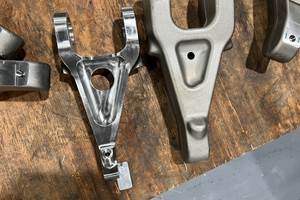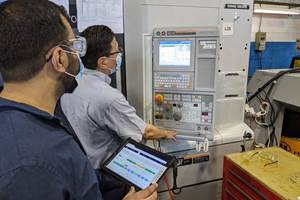Communicating With The Machine Tool
If you continue to operate a bankrupt company in the same manner, you will continue to be bankrupt. This was the primary thought of Steve Brown before he acquired a failed stretch forming company in Gardena, California. Mr. Brown was President of Camarillo Dynamics, an aerospace machining company.
"If you continue to operate a bankrupt company in the same manner, you will continue to be bankrupt." This was the primary thought of Steve Brown before he acquired a failed stretch forming company in Gardena, California. Mr. Brown was President of Camarillo Dynamics, an aerospace machining company.
Mr. Brown merged the two companies into the single Advanced Machine & Stretch forming International, Inc. (AMSI). After making some improvements to the company, he then launched a modernization and equipment refurbishment program designed to improve its standing in machining and stretch forming.
At the center of the equipment list were six Cincinnati Skin Mills with bed lengths of 30 to 70 feet. They were six to 12 years old and had the original Acramatic controllers.
Graham Aerospace, Inc. (Cowansville, Quebec), which had a track record of rebuilding skin mills and fitting them with state-of-the-art controllers, was selected for the AMSI project. A key ingredient of this selection was the company's position as a certified system integrator for the Vickers A2100 machine controller. Graham had recognized that at the heart of the Vickers A2100 controller were dual Intel Pentium powered PCs with the Microsoft NT Operating System. This system allowed Graham to provide customized solutions to specific problems and specific solutions to generalized problems. The A2100 provided a commercial platform that met recognized industry-wide standards and allowed the company to offer value-added implementation of a machine/controller combination.
The system uses the Microsoft networking features for file sharing and for implementing a common work environment to allow schedulers, Q.A. personnel and management to exchange critical production flow information. The system also has Network File System (NFS) that allows it to communicate directly with the Unix-based CAD/CAM system. The CNC programs can be stored off the machine tool and assigned for execution, eliminating current DNC requirements. This feature also permits remote log-in from the A2100 and access to the CAD/CAM software on the Unix-based workstation. Program changes can be accomplished directly from the shop floor. Video images can be viewed at the A2100 monitor.
The AMSI skin mills are equipped with Renishaw probes and the output is delivered to the Unix workstation for evaluation, decision making, and S.P.C. (Statistical Process Control). The output is automatically placed in the Q.A. system for evaluation and action. True vector probing is then integrated into the machine tool controller allowing it to probe any surface while eliminating the CMM machine process requirement. This has the effect of checking the part directly to the original database stored on the Unix workstation. Other probes can be installed on the machine, and intelligent decisions can automatically be made based on their feedback.
One of the first steps that AMSI took was to implement a CAD/CAM system capable of taking advantage of its new machine and control technology. NCL is a powerful Computer-Aided Manufacturing software package that generates simultaneous two-through five-axis NC tool paths and provides parametric 3D modeling. All geometric modeling and tool path functions are fully associative. A change to the model results in an immediate change to corresponding tool paths.
NCL also supports full parametric programming where a family of parts can be machined by simply filling in a form. The parametric ability of NCL combined with the probing and communication capability of the A2100 allows variables to pass from the control to the CAD/CAM system. Tool diameter and length data can be modified at the control and sent to NCL where the tool path is automatically recalculated and sent back to the control. The same procedure can be used to change fixture setups and even make changes to the part geometry.
NCL/IPV (In-Process Verification) simulates the metal removal process right on the computer screen. It allows verification during the programming cycle instead of at the completion of a program as is usually done traditionally. With the NT communications capability of the A2100, a programmer can make a change, verify it using NCL/IPV and run the new version, all without leaving the machine tool. The operator can also play back the IPV file to become familiar with a new program.
NCCS (Newport Beach, California) has developed a special version of its universal postprocessor, PostWorks, which resides on the A2100 control. Through a joint marketing agreement with NCCS, Graham Aerospace is able to provide PostWorks on all A2100s that it sells. This allows the A2100 to accept generic binary or ASCII CL files from virtually any CAD/CAM system. "Using this technology, our NC programmers no longer have to concern themselves with postprocessing at the CAD/CAM system," says Terri Brown, chairman of the board of AMSI.
Both revenue and profit have significantly increased at AMSI. It is expected that these increases will be even more dramatic as the changes are fully implemented and mature.
Related Content
5 Tips for Running a Profitable Aerospace Shop
Aerospace machining is a demanding and competitive sector of manufacturing, but this shop demonstrates five ways to find aerospace success.
Read MoreHow to Turn Machine Shop Downtime Into Process Expertise
To take advantage of a lull in business, JR Machine devised a week-long cutting tool event that elevated the shop’s capabilities with aerospace alloys.
Read MoreHorizontal High-Speed Machining Saves Hundreds of Work Hours
High-speed machining is the latest change at Blair-HSM South, helping this once old-fashioned shop improve productivity and morale while enabling new work.
Read MoreToolpath-Level Machine Monitoring Improves Aerospace OEE
Machine monitoring software that records historical efficiency to the toolpath level helped aerospace manufacturer Leesta improve its OEE by ten points.
Read MoreRead Next
3 Mistakes That Cause CNC Programs to Fail
Despite enhancements to manufacturing technology, there are still issues today that can cause programs to fail. These failures can cause lost time, scrapped parts, damaged machines and even injured operators.
Read MoreThe Cut Scene: The Finer Details of Large-Format Machining
Small details and features can have an outsized impact on large parts, such as Barbco’s collapsible utility drill head.
Read More

























